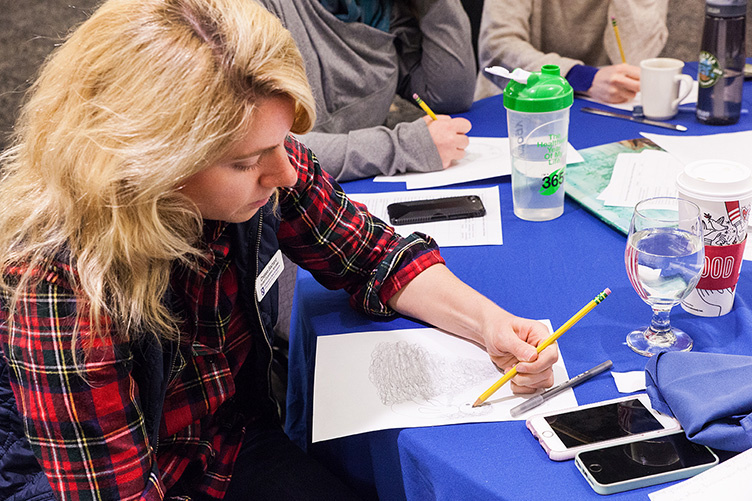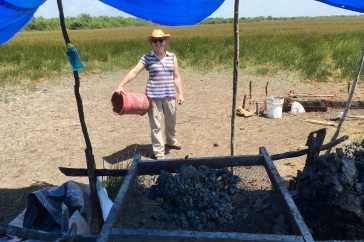
A symposium participant tries her hand at drawing. View the full photo gallery at cola.unh.edu/heal-symposium-photo-gallery.
Can comic books help address mental health issues? An innovative program offered at UNH this fall suggested that they might. Bringing together scholars with cartoonists and a diverse group of community members, the Health Education through Arts and Literature (HEAL) Symposium explored how creating and sharing graphic narratives can support student health and learning.
At UNH as across the nation, mental and behavioral health concerns have been on the rise. Students are reporting more problems with anxiety, depression, and drug and alcohol use; staff, faculty and administration are seeking new ways to support students and one another. Monica Chiu, a professor of English who specializes in Asian American literature, sees a potential remedy in graphic narratives, which she defines as “long-form comics in which images and text are juxtaposed and often in sequence, to paraphrase Scott McCloud, but textless graphic narratives also exist.” Because they combine the power of literature with the impact of graphics, these works can be uniquely effective as teaching and learning tools. Early in 2017, Chiu began assembling an interdisciplinary team to generate research strategies. “The Health Humanities are thoroughly interdisciplinary, requiring our team to be so as well,” Chiu explains. “Our combined interests and insights offer a variety of perspectives, methodologies and intellectual approaches.”
The team, which includes nursing professor Pamela DiNapoli, occupational therapy professor Barb White, Health and Wellness educator Kathleen Grace-Bishop, and Kate Gaudet of the University Honors Program and Humanities department, gained support from the College of Liberal Arts’ Murkland Interdisciplinary Scholars Teams (MIST) program (part of the Grand Challenges in the Liberal Arts Initiative), which provided seed funding as well as coaching by political scientist Alynna Lyon, who professed herself pleased with the result of the collaboration. “The symposium presented a wonderful confluence of scholars and disciplines to address a very real and pressing need on college campuses,” she said. “The project clearly lives up to its name HEAL. I am delighted that MIST could be part of such an innovative and promising research agenda.”
On November 17 the HEAL team presented its first public offering, a one-day symposium that drew attendees from around the region. The Symposium’s featured guests were two local cartoonists, Joel Gill, a faculty member at New Hampshire Institute of Art in Manchester, and Cathy Leamy, who is based in Boston and blogs about health and other issues at metrokitty.com. The two led a series of drawing exercises designed to help participants think through ideas and feelings about stress and anxiety. The hands-on activity complemented more traditional scholarly presentations and panel discussions.
Chiu kicked off the event with an overview of the field of health humanities, which brings perspectives from the arts, philosophy, history and other humanistic disciplines to medical topics. White presented a summary of data about UNH students’ mental health, including a survey conducted by the HEAL team this fall. On a faculty panel, philosopher Charlotte Witt discussed how mental illness fits into current work in disability studies; Larry Beemer of the English department described his use of superhero comics in the classroom; and psychologist Victoria Banyard shared research on classroom interventions that can change students’ self-perceptions and performance. Current UNH students Andrea Engen, Amanda Plante and Dieuvil Varice shared their experiences and opinions regarding the mental health climate at UNH.
Amanda Plante, a senior English major, was inspired by the Symposium and the conversations it generated. “The perspectives, resources and support I received from UNH community members and panelists who attended inspired me to pursue research on graphic portrayals of mental illness for my senior thesis this spring,” she said. Attendee Cory Levine, a faculty member at New Hampshire Institute at Art, found it similarly exciting. “I came away from the HEAL symposium heartened to find that within the largest academic community in New Hampshire there exists a cohort of scholars dedicated to this issue,” he said. “I am inspired by the richness of the dialogue around using the arts, and specifically graphic narrative, as a part of the solution. All who attended were eager to bring their diverse perspectives to bear on a critical problem and seek positive change for students at the intersection of art and science. As an instructor and practitioner in the field, I return to both my classroom and studio with new ideas on how to address student concerns, and great optimism about the direction of dialogue.”
The HEAL team will continue to meet to consider how to expand the use of graphic narratives as tools for promoting student health and wellness. The HEAL Symposium was a promising first step in an exciting ongoing project for UNH and the New Hampshire community.
-
Written By:
Katherine Gaudet | Hamel Honors and Scholars College | kate.gaudet@unh.edu

















































